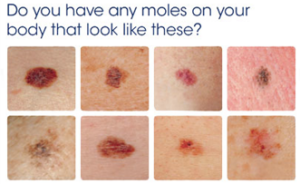
Every time you see a picture of a melanoma, it’s either black, grey, some shade of brown, magenta, red, bluish, purple or pink, but never yellow.
However, the color of yellow is absolutely possible in a melanoma.
The pigment-producing cells of the body, called melanocytes, produce melanin, the compound that gives skin and moles their color, which can be brown, even black, tan, gray or blue.
Yellow, on the other hand, is not associated with melanin, but rather with keratin or fats.
The skin cancer that more commonly displays yellow is squamous cell carcinoma.
A report in Dermatology Practical & Conceptual (April 2014) focuses on a 76-year-old woman who developed a yellow melanoma on her cheek.
Upon dermatoscopic examination (special lighted magnification lens), yellow and pink areas were noted, along with grey (note the arrows in the image above).
The grey suggests a type of melanoma called lentigo maligna.
However, a biopsy revealed an amelanotic nodular melanoma.
The study authors were not able to determine what the cause of the yellow was.
The paper states, “…we like to conclude that yellow color upon dermatoscopy should not lead clinicians to exclude a diagnosis of melanoma.”
The above case involves a less common melanoma in an elderly patient.
The next case, also reported in the same issue of DP&C, is a bit more chilling, as the patient was 44 at the time of diagnosis, and her yellow melanoma was the common superficial spreading type.
The study authors speculate that the yellow was being caused by a pigment called lipofuscin, “which is known to produce subtle orange color in some choroidal melanomas,” states the paper.
This yellow melanoma, as revealed by dermapathology analysis, had originated from a mole.
“Melanoma can appear in any color,” says Dr. Tess Mauricio, MD, FAAD, a leading board certified dermatologist from Stanford University Medical School and CEO of MBeautyClinic.com.
If you have a newly developing yellowish mole-like or nodular growth, just have it biopsied; get it over with.
“Asymmetry and irregularity in color along with changes to existing coloration are signs of melanoma,” says Dr. Mauricio.
Better to be safe than sorry. A prompt and negative biopsy will bring peace of mind, but a delayed and positive biopsy can mean death.

Always alert your doctor to a worrisome or “funny” mole or one that has been changing.












